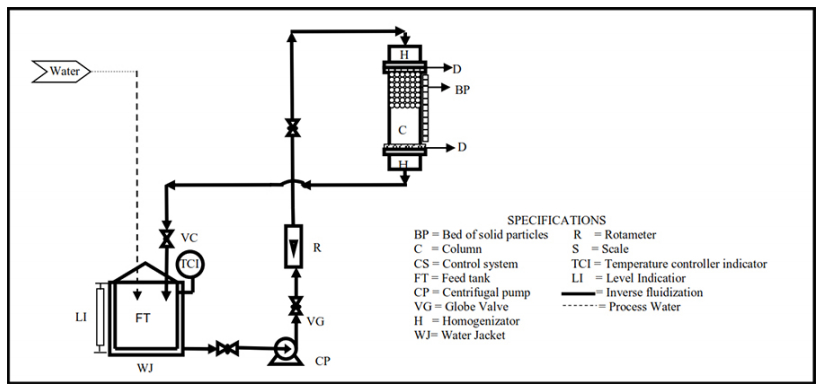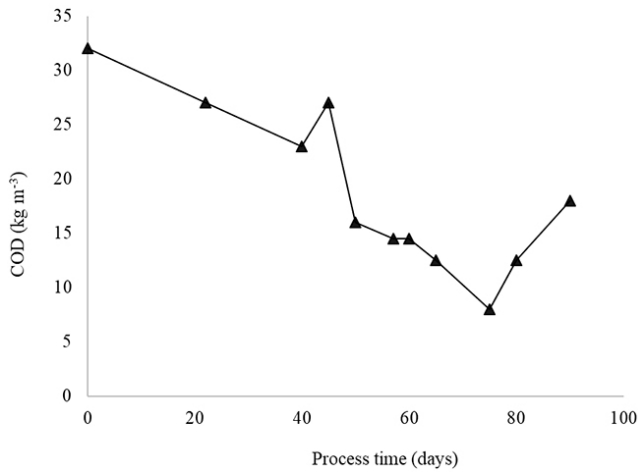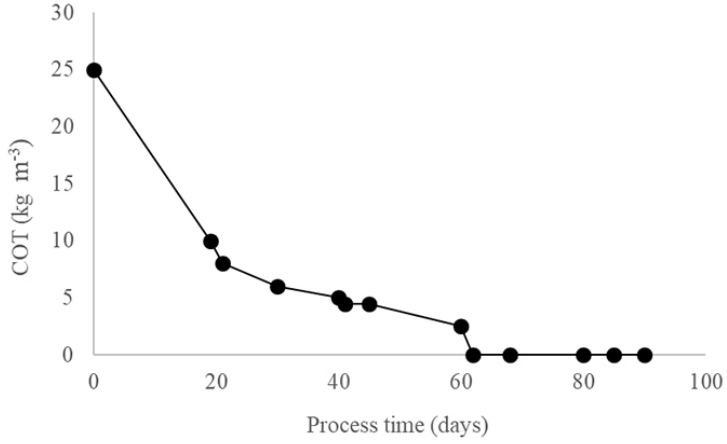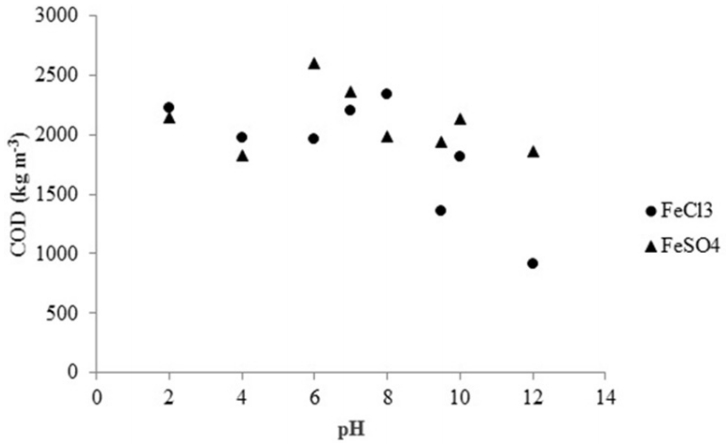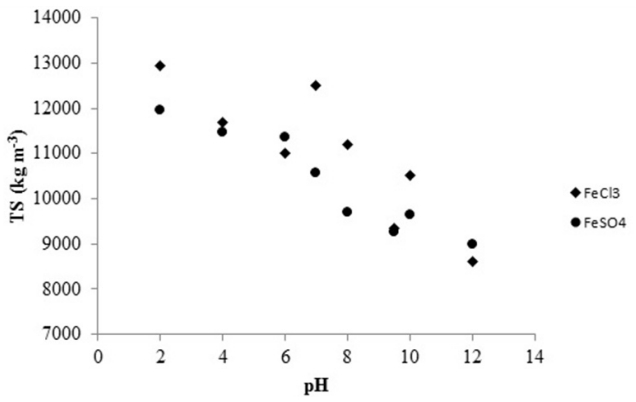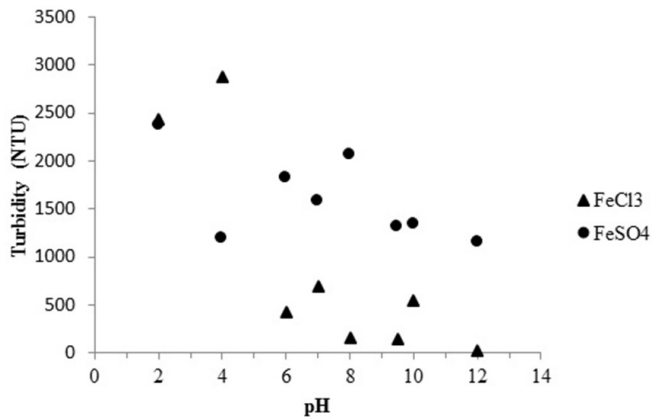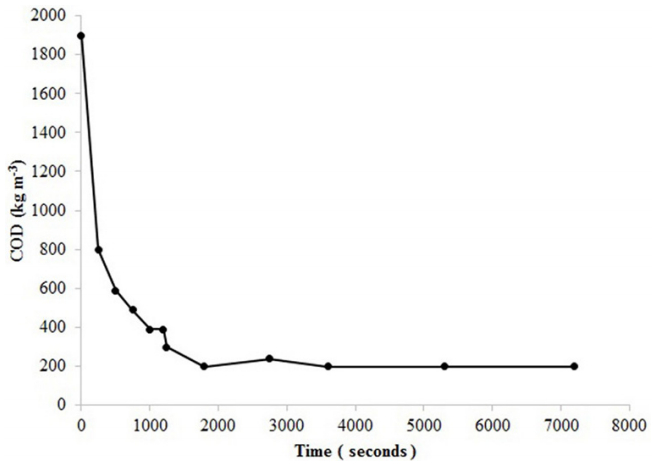Vinasse is the wastewater generated from ethanol distillation; it is characterized by high levels of organic and inorganic matter, high exit temperature, dissolved salts and low pH. In this work the treatment of undiluted vinasse was achieved using sequentially-coupled biological and advanced oxidation processes. The initial characterization of vinasse showed a high Chemical Oxygen Demand (COD, 32 kg m-3), high Total Organic Carbon (TOC, 24.5 kg m-3) and low pH (2.5). The first stage of the biological treatment of the vinasse was carried out in an inverse fluidized bed bioreactor with a microbial consortium using polypropylene as support material. The fluidized bed bioreactor was kept at a constant temperature (37 ± 1ºC) and pH (6.0 ± 0.5) for 90 days. After the biological process, the vinasse was continuously fed to the photoreactor using a peristaltic pump 2.8 × 10-3 kg of FeSO4•7H2O were added to the vinasse and allowed to dissolve in the dark for five minutes; after this time, 15.3 m3 of hydrogen peroxide (H2O2) (30% w/w) were added, and subsequently, the UV radiation was allowed to reach the photoreactor to treat the effluent for 3600 s at pH = 3. Results showed that the maximum organic matter removed using the biological process, measured as COD, was 80% after 90 days. Additionally, 88% of COD removal was achieved using the photo-assisted Fenton oxidation. The overall COD removal after the sequentially-coupled processes reached a value as low as 0.194 kg m-3, achieving over 99% of COD removal as well as complete TOC removal.
1.
Introduction
The intensifying demand for several industries has led the world to a concerning upsurge in the production of injurious gases, which openly damage the environment. This mounting demand is mostly driven by population increase, development, and user needs, putting tension on energy resources. To deal with the huge demand for energy, the energy production sector and other industries are releasing greenhouse gases and other toxins into the atmosphere, escalating worldwide environmental issues such as climate change and air pollution.
The energy production sector and industries deeply depend on fossil fuels, like petroleum, methane, and coal, utilized for generating energy and manufacturing processes. The energy produced through the burning of fossil fuels leads to the emission of substantial quantities of carbon dioxide (CO2), which is accountable for trapping heat in the atmosphere, triggering global warming. The drastic changes in climate change, the significant increase in energy demand and an upsurge in fossil fuel prices compel the world on the road to the addition of green renewable energy sources (GRES) along with fossil fuel-based conventional sources [1]. The incorporation of solar, wind, and hydropower sources into energy systems is a transformative strategy that aligns industrial growth with environmental stewardship [2]. The study explores the impact of clean energy and carbon markets on environmental sustainability, investigating interdependencies and spillover effects between global carbon and GRES like wind, solar, biofuel and geothermal [3]. This approach not only caters to the escalating energy requirements but also paves the way for a cleaner, more sustainable future, fostering a harmonious coexistence between industrial progress and ecological preservation [4]. Optimal Power Flow (OPF) emerges as a pivotal optimization challenge within power systems, seeking to minimize generation expenses while upholding operational limitations. With the rising integration of GRES like wind, solar, and hydropower sources, the complication and non-linearity of the OPF problem further intensify [5]. However, to address this intermittent and fluctuating nature of GRES, batteries are required [6].
Over the past few years, numerous optimization algorithms and approaches have been created and applied to address the optimization challenges associated with the OPF problem. These include traditional techniques, evolutionary strategies, and sophisticated metaheuristic algorithms. Linear programming (LP) is a conventional method applied to solve OPF problems, as cited in [7]. Non-linear programming (NLP) technique presented in [8] has been employed for addressing OPF problems. Quadratic programming (QP) has been utilized in solving OPF problems by the researchers in [9]. Dynamic programming (DP) represented in [10] is another traditional approach applied to address OPF problems. The interior point (IP) method, as outlined in [11], has been employed in tackling of OPF problems. Nevertheless, these classical approaches encounter limitations when dealing with large-scale problems due to their complex and intensive computations, as well as their prominent reliance on initial estimation values. Algorithms derived from the principles of evolution mimic the evolutionary process, generating successive generations through mating to achieve optimal solutions. The authors in [12] have utilized the genetic optimization algorithm (GOA) to tackle the OPF in distribution systems. Enhanced genetic algorithm (GA) has been used in [13] for the solution of multi objective OPF problem. Another notable contender in this category is the Differential Evolution (DE) algorithm, which has demonstrated efficacy in handling constraints while optimizing diverse objectives within the OPF context [14]. In order to prevail over the limitations of conventional and evolutionary-driven approaches, a number of heuristic algorithms were adeptly employed to address the OPF challenge. Particle swarm optimization (PSO), as cited in [15], stands out as a prominently used metaheuristic algorithm for solving OPF problems. Moth-flame optimization (MFO) algorithm discussed in [16], is another metaheuristic algorithm widely employed in the context of OPF solution. The multi-verse optimization (MVO) algorithm, as introduced in [17], is recognized as a prominent metaheuristic approach for addressing OPF challenges. Moth-swarm algorithm (MSA), described in [18], is among the widely used metaheuristic algorithms in the field of OPF solution. The elephant herding algorithm (EHA), outlined in [19], is acknowledged as a notable metaheuristic approach for optimizing OPF problems. Gravitational search algorithm (GSA), detailed in [20], is recognized as a key metaheuristic algorithm applied in the resolution of OPF issues. The whale optimization algorithm (WOA), discussed in [21], is a notable metaheuristic approach frequently utilized for solving OPF problems. Grey wolf optimization (GWO), highlighted in [22], is a metaheuristic algorithm extensively used in the domain of OPF solution. The ant lion algorithm (ALA), introduced in [23], is recognized as a significant metaheuristic approach for OPF optimization. The grasshopper algorithm (GA), as cited in [24], is recognized as a noteworthy metaheuristic algorithm employed for OPF solution.
In the struggle of enhancing the global search competences of metaheuristic algorithms, the combination of two algorithms has been undertaken to attain globally optimal results. One of the algorithms used for OPF is the fusion of dragonfly and PSO (DA-PSO), as proposed in reference [25]. This hybridization of both algorithms harnesses the strengths of both, augmenting their abilities in both exploitation and exploration. The efficacy of the selected DA-PSO algorithm has been substantiated through testing on systems involving IEEE 30 and 57 buses, encompassing various objective functions. PSO-GSA, as referenced in [26], is an optimization algorithm distinctively applied to address OPF problems. Harris hawk optimization combined with DE (HHODE), introduced in [27], represents an innovative approach for OPF optimization. Hybridizing cuckoo search with GWO (HCSGWO), detailed in [28], is a unique optimization algorithm employed in solving OPF challenges. The combination of cross entropy with CSA (CE-CSA), as discussed in [29], offers a novel strategy for addressing OPF optimization concerns. A hybrid PSO-GWO algorithm has been employed in [30], to address the OPF problem for IEEE modified 30-bus systems including solar and wind energy sources. The researchers in [31] employed the enhanced computational optimizer of the social network search technique (ESNST) to find multidimensional OPF solutions for IEEE-30, 57, and 118 bus systems, without taking into account the integration of GRES. The gorilla troops optimization technique (GTOT), inspired by the collective behaviors of gorilla groups, has been successfully applied to optimize fuel costs, emissions, and power losses in IEEE-30 bus systems [32].
The IEEE 30 bus system is a well-known benchmark system employed for assessing the usefulness of optimization algorithms in power systems. This study proposes a GWPSO algorithm to alleviate generation costs, power losses and pollution emissions for a system integrated with GRES such as wind turbine (WT), solar photovoltaic (SP) and small hydropower (SHP) sources. The GWPSO algorithm merges the exploration competence of the GWO algorithm with the exploitation competence of the PSO algorithm. The usefulness and proficiency of the proposed algorithm are assessed by comparing it with other optimization techniques such as PSO and GWO. This work is a continuation of the earlier works [5,30], where OPF problem is solved for IEEE modified 30 bus systems integrated with solar and wind energy sources using HPS-GWO and PSO-GWO algorithms, respectively. Validation is endorsed via comparison with SHADE-SF, GWO, and PSO.
The rest of the paper is organized as follows. Section 2 presents the OPF formulation for IEEE 30 bus system integrated with WT, SP and SHP sources. Section 3 describes the uncertainty modeling and probability density functions (PDFs) for WT, SP and SHP sources. Section 4 presents the proposed GWPSO algorithm. Section 5 provides details of the simulation outcomes and analysis. Finally, in Section 6 the paper concludes by providing a concise over-view of the findings and offering suggestions for potential avenues of future research.
2.
Formulation OPF and determination of cost functions
The methodology involves the formulation of OPF with GRES, formulation of the Objective/Cost Function, modeling the uncertainty of GRES, hybridization of the GWO with PSO algorithm, setting initialization and termination criteria, and conducting performance evaluation and result validations. The IEEE 30-bus system in its standard form comprises twenty-four buses for load distribution and six buses for generators, where thermal generators (TGs) are linked. In the suggested altered system, three TGs have been substituted with two WTs sources (at buses 5 and 11) and a SP source combined with a SHP source (at bus 13). This replacement aims to formulate an OPF as an optimization challenge characterized by both inequality and equality constraints to reduce emissions and generation costs [30]. The essentials of the system being examined, as outlined in Table 1, include TGs, WTs and SP combined with SHP sources. Moreover, Figure 1 illustrates the composition of the test system under study.
2.1. The cost functions for thermal generators (TGs)
The detailed mathematical modeling of the system can be found in [5], where two WT and a SP source are connected. The output power of TG relies on fossil fuels. The correlation between the produced power (MW) and the cost of fuel ($/hr) can be determined using the subsequent quadratic equation:
CTG denotes the overall cost where the parameters ai, bi, and ci signify the fuel cost coefficients for the ith TGs, and their specific values are detailed in Table 2.
For accurate modeling of the cost function for TGs, the valve point effect needs to be considered.
In Eq (2) ei and di denote the valve point effect coefficients of steam turbines.
The amount of emission (ton) released from each TG is computed through Eq (3).
The emission coefficient ωi and μT specific values are provided in Table 2.
In order to diminish the release of detrimental emissions and promote the incorporation of eco-friendly and economically viable GRES like SP, WT, and SHP sources, a carbon tax is implemented based on the amount of emissions produced per unit [33]. The cost associated with emissions ($/hr) for TGs is outlined as follows [5]:
The numerical values of cost and emission coefficients for TGs employed in Eqs (1)–(4) are provided in Table 2 and these values are in accordance with reference [5].
2.2. The cost functions for wind turbines (WTs) sources
Unlike TGs, GRES do not involve any ongoing costs of fossil fuel, as they do not need fossil fuel for power generation, a price per unit production may be assigned for considering the initial investment compensation, renovation and maintenance costs to GRES. The direct, reserve (due to overestimation) and penalty (due to underestimation) costs linked with each WT source, are formulated as follows [5]:
Equations (5)–(7), Pw−sch,j depicts the scheduled output power and Pwac,j denotes the actual output power from jth WT source. The gw,j, KRw,j, and KPw,j represents direct, reserve and penalty cost coefficient of jth WT sources, respectively, there numerical values are mentioned in Table 3.
The entire cost of WT sources is computed as:
2.3. The cost functions for solar photovoltaic (SP) and small hydropower (SHP) sources
This work is using a SP and a SHP source as the third GRES. The SHP source output contributes to a small proportion of the total system capacity [34]. As a result, it is combined with the SP source at bus 13 and is supposed to be owned by a sole private operator. The direct, reserve (due to overestimation) and penalty (due to underestimation) of the combined SP and SHP sources are calculated using the subsequent equations, respectively.
In Eq (9), Ps−sch,k, Php−sch,k, hk, and hl depicts the scheduled power and the coefficients for direct costs of SP and SHP sources, respectively. KR−sh and KP−sh represents the coefficients for reserve and penalty costs relating to kth combined SP and SHP sources, respectively. Psh−sch,k and Psh−ac,k represent scheduled and actual available output power from combined SP and SHP source, respectively. The total cost of the combined SP and SHP source is calculated as follows:
2.4. The Formulation of main objective function for optimization
In this research work, three objective functions have been formulated to optimize the overall generation cost. The first objective function is modeled to calculate overall generation cost, disregarding the valve point effect of TGs. It is expressed as follows:
The second objective function considers the valve point effect of TGs and is formulated for the total generation cost as follows:
The third objective function considers a carbon tax (20$/ton) on emissions from TGs and is formulated as follows:
In Eqs (13)–(15), the individual cost of each source, CTG, CTG−V, Cemi, Ct−WT and Ct−sh are calculated using Eqs (1), (2), (4), (8) and (12), respectively.
Several equality, inequality, and security constraints are present, with their modeling details and mathematical equations as presented in [5,30]. The power loss (MW) and voltage deviation (p.u.) are the two other important parameters that can be calculated using the subsequent equations.
The δij=δi−δj represents the voltage angle difference between two buses, Gij denotes transfer conductance, and nl signifies the overall count of lines within the network.
3.
The formulation of stochastic power of green renewable energy sources
The output power of GRES is of stochastic nature due to their dependency on weather conditions, which are characteristically variable and indeterminate. The output power of GRES is altered by factors like haze, temperature, wind speed and river flow rate. To formulate the stochastic power output of GRES, it is necessary to consider probabilistic models that illustrate the inconsistency and unpredictability linked to their power output.
a) The formulation of stochastic power of wind turbine (WT) sources
The wind speed distribution exhibits a similar distribution like Weibull PDF and is mostly employed for modeling wind speed distribution [5]. Utilizing a Weibull PDF characterized by a shape factor (k) and a scale factor (c), the probability of wind speed fv(w)(m/s) as a function of wind speed (v) can be derive using the subsequent expression:
The values of shape (k) and scale (c) parameters have been extracted from the references [5] and are provided in Table 3. Figures 2 and 3 showcase the Weibull fitted curve and frequency distribution curves for wind speed of WTs sources at bus 5 and 11, respectively. These graphs are generated through the execution of 8000 Monte Carlo scenarios in the simulation.
The generated power output of WTs sources relies on wind speed and can be computed in the following manner:
where vin, vr and vout denote the cut-in, rated, and cut-out wind speeds, respectively.
b) The formulation of stochastic power of solar photovoltaic (SP) source
The power output from the SP source depends on solar irradiance (G), which obeys lognormal PDF [5]. This lognormal PDF is characterized by a mean value (μ) and a standard deviation (σ) and it can be employed to determine the statistical distribution of solar irradiance (σ) using the subsequent equation:
The variables associated with lognormal PDF are provided in Table 4, kept the same as cited in the source [5]. Upon execution of 8,000 Monte Carlo simulations, Figure 4 displays both the frequency distribution of solar irradiance and the lognormal fitting curve.
The mathematical representation of the generated power from the SP source, which depends on solar irradiance (G), is presented in Eq (21).
The particular irradiance value is represented by Rc and is set at a value of 120 W/m².
The formulation of stochastic power of small hydropower (SHP) source
In the adapted IEEE 30-bus network, the traditional TG source at bus 13 is substituted with a 50 MW SP and a 5 MW small SHP source. It is widely recognized that the river flow rate conforms to the Gumbel distribution [34]. The probable dissemination of the river flow rate Ghp, adhering to the Gumbel distribution fhp(Ghp) characterized by the location parameter λhp and scale parameter ωhp, can be formulated as:
The associated PDF values for these adjustments are detailed in Table 4, with numerous selections made in accordance with a comprehensive investigation cited in Reference [34]. Figures 5–8 depict the real power availability and river flow rate distribution for both SP and SHP sources.
The amount of power generated by a SHP source relies on both the rate of water flow (Ghp) and the actual pressure head (h). The output power from SHP can be formalized as follows [34]:
where ηhp and δhp denotes the efficiency of the SHP and water density, respectively.
The numerical values involved in the calculation of the SHP source output are kept the same as in reference [34], which are: ηhp = 0.85, δhp = 1000kg/m3, h = 25m, and g = 9.81m/s2.
4.
The proposed grey wolf particle swarm optimization (GWPSO) algorithm
In this study, the GWPSO algorithm was employed to optimize the three objective functions discussed earlier. The GWO algorithm replicates the hierarchical hunting and leadership patterns of gray wolves, whereas the PSO algorithm takes inspiration from the collective behaviors exhibited by flocking birds. The GWO algorithm outperforms in exploring the entire exploration area, but exhibits slower convergence and limited local search capability, whereas the PSO algorithm excels in exploitation but can become trapped in local optima [35]. In this study, an algorithm named GWPSO is proposed, which improves GWO's exploration with PSO's exploitation competence to make a collaborative algorithm. The flowchart depicting the chosen GWPSO algorithm is presented in Figure 9.
In the formulated GWPSO algorithm, the coordinates of alpha (dα), beta (dβ) and delta (dδ) within the exploration space are progressively adjusted using the subsequent sequential equations [5]:
In the aforementioned expression, the abilities of gray wolves are synchronized within the search region through the use of a momentum constant (ci) and inertia weight (ω). The modified equations for position (xk+1i) and (vk+1i) velocity undergo the following changes [5]:
5.
The simulation results and analysis
This study focuses on integrating a SHP source into the modified IEEE 30 bus system, along with integrated WT and SP sources. The main contribution lies in the development of a GWPSO algorithm, aiming to minimize the total generation cost in this hybrid energy system. The optimization of the overall generation cost has been categorized into three scenarios: One without including the valve point effect, one with the valve point effect, and another involving a carbon tax on TGs emissions. Every optimization algorithm is executed five times, for an accumulated sum of 500 iterations in each execution. In each case the results of GWPSO are compared with GWO, PSO and with the previous research as cited in reference [5], where only WTs and SP sources were integrated. In each case, results indicate a decrease in the range of 2.211 to 3.434 $/h has been observed after incorporating the SHP source into the system. The success of the proposed GWPSO algorithm can be attributed to its effective combination of the exploration capabilities of GWO and the strong convergence abilities of PSO algorithms. The major shortcoming of the proposed algorithm is that its execution time is longer than that of individual algorithms. The study under research provides a solution to the IEEE 30 bus system with integrated GRES while considering static loads. The dynamic nature of load and storage batteries as a backup source to mitigate the uncertain nature of GRES is left for future research work.
5.1. Case 1: Variations in different types of cost as a function of PDF parameters
This scenario examines the interdependencies among reserve cost, penalty cost, direct cost, and total cost for SP and WTs sources in relation to lognormal and Weibull PDF variables, respectively. Maintaining a constant shape parameter (k = 2) while varying the scale parameter (c) within the range of 2 to 16. The corresponding cost changes are then observed at fixed scheduled power outputs of 25 MW for WT1 and 20 MW for WT2. These selected power levels represent approximately one third of the overall deployed set up, which aligns with typical practical WT capacity percentages ranging from 30% to 45% [5]. Figures 10 and 11 illustrate the cost curves for WT1 and WT2 sources respectively. Notably, the minimum total cost occurs when the scale parameter (c) is around 9.
Similarly, the SP costs are examined against lognormal mean (µ) spanning from 2 to 7, while maintaining the value of standard deviation σ at 0.6 and a scheduled power output of 20 MW from the SP source. The analysis reveals that the minimum total cost is achieved when the lognormal mean value is set at 6. After µ reaches 6, the penalty and reserve costs converge, but beyond this point, the penalty cost sharply increases, leading to an escalation in total cost. The output power of the SP source is particularly sensitive to the lognormal µ, with higher values of µ requiring greater reserve capacity and vice versa. Figure 12 visualizes the variations in SP cost in relation to the lognormal µ.
5.2. Case 2: Variations in different types of cost as a function of scheduled output power
This scenario examines the impact of varying the planned wind power for two WT sources linked to buses 5 and 11. The scheduled wind power ranges from zero to the WT's rated power has been examined how the reserve cost, penalty cost, direct cost and total cost change accordingly, as illustrated in Figures 13 and 14. The simulation findings indicate that the reserve cost decreases with an increase in the scheduled WT power, indicating an inverse relationship. Conversely, the penalty cost increases with higher scheduled power levels. Interestingly, there exists a direct relationship between the planned wind power and direct cost. The total cost demonstrates an upward trend as the scheduled power increases, as it includes the combination of reserve cost, penalty cost and direct cost elements.
In a similar manner, the performance of the SP source connected to bus 13 in terms of reserve cost, penalty cost, direct cost and total cost relative to the SP schedule power has been analyzed, as illustrated in Figure 15. The various parameters and cost coefficients can be found in Tables 3 and 4 for reference. Unlike the wind scenario, the total cost for the SP source attains its minimum value at approximately 15 MW.
5.3. Case 3: Minimizing the overall generation cost ignoring the valve positioning influence for TGs
In this case, the overall generation cost has been optimized ignoring the valve positioning influence for TGs as formulated in the first objective function in Eq (13). The numerical values of control and constraints parameters obtained from GWO, PSO, and GWPSO, along with the respective values of our previous research work [5], have been considered in Table 5 for the purpose of comparison. The graphs illustrating the convergence trends of GWO, PSO, and the GWPSO algorithms in Figure 16 reveal that the GWPSO approach displays a rapid and consistent curve. The lowest generation cost achieved through GWPSO is 769.302 $/h, which is 3.434 $/h less than that reported in [5], and this difference becomes a significant amount of (3.434×24×365) 30081 $/Y.
5.4. Case 4: Minimizing the total generation cost excluding a carbon tax on emissions from TGs
In this case, the total generation cost has been optimized with consideration of the valve positioning influence for TGs, excluding the incorporation of a carbon tax on TGs emissions as formulated in the second objective function in Eq (14). The numerical values of control and constraints parameters obtained from GWO, PSO, and GWPSO, along with the respective values of our previous research as cited in [5], have been compiled in Table 6 for the purpose of comparison. Figure 17 depicts the convergence curves for the GWO, PSO, and GWPSO algorithms. The achieved minimum generation cost by GWPSO is 778.171 $/h, which is 2.416 $/h less than that reported in [5], and this difference becomes a significant amount of (2.416×24×365) 21164 $/Y.
5.5. Case 5: Minimizing the overall generation cost including a carbon tax applied to emissions from TGs
In this scenario, the total generation cost has been optimized with the inclusion of both the valve positioning influence and a carbon tax applied to emissions from TGs, as formulated in the third objective function in equation 15. The numerical values of control and constraints parameters obtained from GWO, PSO, and GWPSO, along with the respective values of our previous research work [5], have been consolidated in Table 7 for the purpose of comparison. Figure 18 depicts the convergence patterns of the GWO, PSO, and GWPSO algorithms. The achieved minimum generation cost by GWPSO is 807.066 $/h, which is 2.211 $/h less than that reported in [5], and this difference becomes a significant amount of (2.211×24×365) 19368 $/Y. Following the implementation of a carbon tax (20$/ton) on emissions, a reduction of 0.847 ton/h has been observed, this becomes a significant amount of (0.847x24x365) 7420 ton/Y as depicted in Tables 6 and 7.
6.
Conclusions
This study offers a green and economic approach for solving the OPF problem, combining conventional TGs with WTs, SP, and SHP sources by utilizing a GWPSO algorithm. The intermittent nature of WTs, SP, and SHP sources is modeled with Weibull, Lognormal, and Gumbel PDF, respectively. The total generation cost has been optimized while considering the constraints of the system, including equality, inequality, and line capacity constraints. The effectiveness and flexibility of the GWPSO algorithm have been evaluated using a test system that incorporates GRES. The superiority of the GWPSO algorithm has been validated through comparison with the outcomes of the PSO and GWO algorithms. The addition of SHP source along with WTs and SP source has been proven fruitful in the reduction of overall generation cost. The inclusion of a carbon tax led to a decrease in emissions by 7420 tons/Y, leading to a higher penetration from GRES. The main drawback of the suggested algorithm is its longer execution time compared to individual algorithms. The study focuses on addressing the IEEE 30 bus system with integrated GRES, taking static loads into account. However, the dynamic aspects of load and the utilization of storage batteries as a backup to manage the uncertainty of GRES are designated for future research. In the future, the GWPSO algorithm will find effective applications in higher bus systems such as IEEE 57 and IEEE 118 bus systems expansions and planning studies.
Use of AI tools declaration
The authors declare that they have not used Artificial Intelligence (AI) tools in the creation of this article.
Acknowledgements
The authors are thankful to the Deanship of Scientific Research at Najran University for funding this work, under the Distinguished Research Program grant code (NU/DRP/SERC/12/7). The authors extend their appreciation to the Deanship of Scientific Research at King Khalid University for funding this work through large groups under grant number RGP2/105/44.
Conflict of interest
The authors declare no conflicts of interest.









 DownLoad:
DownLoad:




















